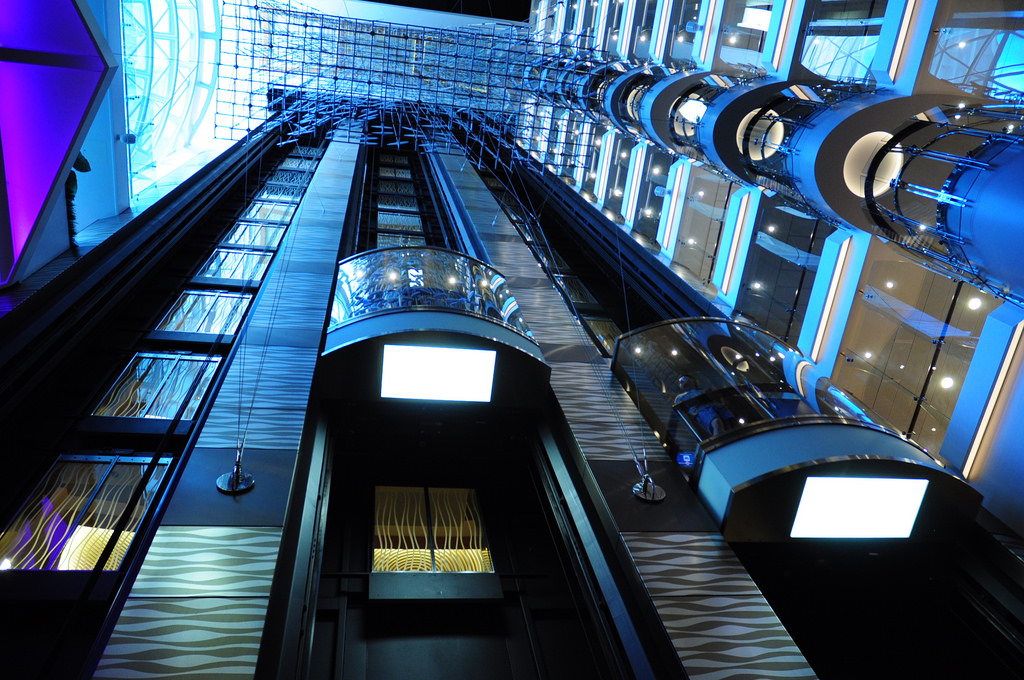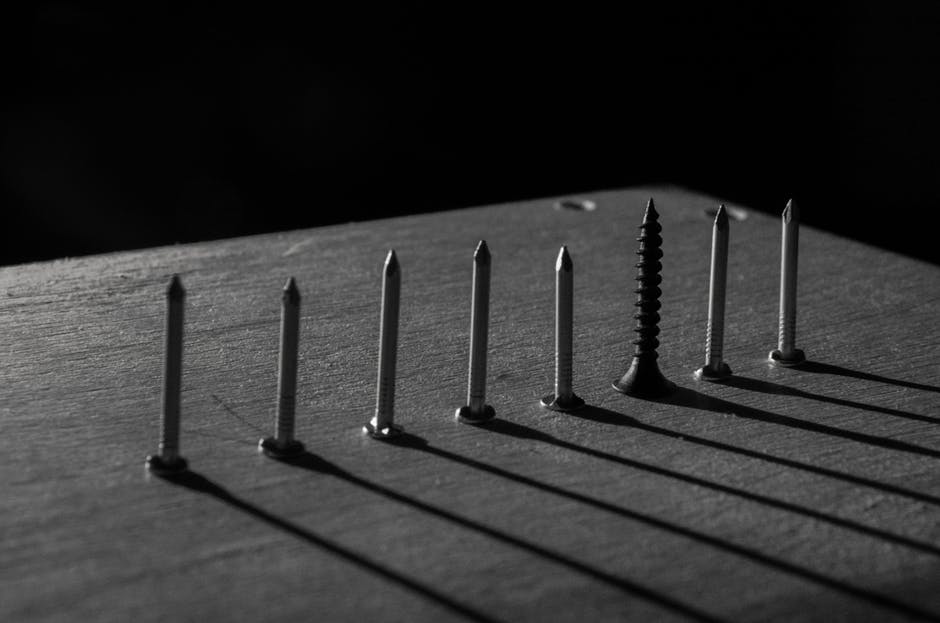Step 1
Use the cardboard box to make the elevator car. This can be done by cutting five 15 cm by 15 cm squares from the cardboard and taping them together to form an open topped box.
Step 2
Thread a string through the top of the box to form a small loop. Repeat at the bottom of the box.
Step 3
Arrange the six spindles on the plywood as shown in Figure 1. Leave approximately 10 cm between spindles in the same line. Try to align the spindles.

Step 4
Fix the spindles to the wood using the nails.
Step 5
Place the box on the board as shown in Figure 1.
Step 6
Tie a string to the loop at the bottom of the elevator car. Pass the string under spindles 5 and 6 and over the tops of spindles 1 and 2. Wind the string twice around spindle 2. Tie the end of the string to the loop at the top of the box. The arrows in Figure 2 can be used as a guide.

Step 7
Tie another piece of string to the loop at the top of the box. Pass the string over spindles 3 and 4. Leave a long length of string hanging over spindle 4. The arrows in Figure 2 can be used as a guide.
Step 8
Tie the counterweight to the end of the string at spindle 4.
Step 9
Ensure that all the spindles are firmly in place and that all the cables are tight and secure.
Step 10
Use your hand to turn spindle 2. In which direction does the elevator car move? How does turning the spindle in the opposite direction affect the motion of the elevator? How does the counterweight influence operation?
A small box could be used for the elevator cab, instead of constructing a box from scratch using pieces of cardboard.
Thread or baker’s twine could be used instead of string.
- An adult should hammer the nails into the board if younger children are carrying out the experiment.
- When hammering nails into the board, keep fingers out of the way of the hammer. Use firm, precise blows.
- Be careful not to strike the spindle. If the spindle cracks its fragments may hit your eyes.
Imagine a seesaw. If a heavy boulder which weighed more than you were placed on the opposite end of the seesaw, it would hold one side of the plank on the ground. Even if you climbed up onto the other end, jumped on it even, you wouldn’t be able to lift the boulder off the ground.
Now, imagine a second boulder with half the weight of the first is placed on the side which you have been sitting on. Now, the weight from the second boulder, paired with some extra force from you, is enough to start moving the grounded end of the seesaw. Once the seesaw is moving, it has momentum, and so it requires relatively little effort on your part to continue moving until it reaches the top position. Once it reaches the top position, extra force must be used to keep it there. Possibly your friend could join you in holding down the end of the seesaw, so the combined force on the newly grounded end of the plank is enough to keep the heavier boulder at the maximum point.
Lifts work a lot like seesaws. The heavy boulder represents the passengers (load) in the cab. The second boulder on the opposite end represents the counterweight. You represent the motor, which provides extra force to move the boulder. Your friend represents the brakes, which come into action to stop the cab from moving once it reaches the desired floor. The plank of the seesaw represents the cables connecting the cab to the counterweight.
What happens if the cables snap?
The speed governor activates the emergency brake.
If the elevator is in freefall, will jumping before you hit the ground save your life?
Probably not.
What happens if the governor doesn’t work?
There are additional braking features and absorption mechanisms at the bottom of the lift shaft.
How does the motor move the elevator?
The motor rotates the shaft, which turns the sheave.
Why does the sheave have grooves?
Grooves create friction to hold the cables in place.
Why is a counterweight needed?
To reduce power required from the motor.
Do lifts have brakes?
Lifts have a number of braking systems.
How heavy is the counterweight?
Usually half the weight of a full cab.
Elevator movement is driven by an electric motor found at the top of the elevator shaft. (Video). A special wheel called a sheave is attached to the shaft of the motor. Steel cables are passed over the sheave. The cab, which carries passengers, is attached to one end of the cables while a counterweight is attached to the other end. Together, the sheave and cables form a pulley system. The sheave has a number of grooves which hold the cables in place through friction.
The counterweight is a steel frame full of weights. It offsets the weight of the cab. This means that the force which needs to be produced by the motor in order to move the elevator is equivalent to the difference between the weight of the cab and the counterweight. Thus, the counterweight reduces the power required from the motor and reduces wear on the moving systems. Typically the counterweight would be half the weight of a full cab.
The motor controls the movements of the cab and counterweights. When it rotates in one direction, the cab ascends and the counterweight descends. When it rotates in the opposite direction, the movement is reversed. Lifts are installed with a number of braking systems and failsafe protection mechanisms.
The cab starts to move because there is a resultant force upwards or downwards. This resultant force causes the cab to accelerate. Equation 1 summarises the relationship between the resultant force, F, the mass of the cab, m, and the acceleration, a. A heavier cab will accelerate less for the same resultant force.
F = ma (Eq 1)
In order to move the cab upwards, the resultant upward force must exceed the downward forces produced by the weight of the cab structure and passengers. When the cab moves downwards, the weight the cab and passengers produces a downwards force, and the motor can apply a braking force to control the speed of the cab.
The counterweight plays an important role in elevator operation. The counterweight makes it easier to move the car. The motor only needs to supply a force equivalent to the weight difference between the cab and the counterweight and some extra force to overcome friction in the pulleys. Since the motor has to do less work against gravity in order to move the cab, less power is expended by the motor, reducing the motor specifications and energy expenditure. Reducing the force decreases the strain in the cables, decreasing wear and adding an extra layer of safety. The counterweight mechanism makes it easier to control the speed of the lift. It also decreases the braking forces required in the case of an emergency.
Lifts contain a number of safety features. Guides are used to control and stabilize the movements of the cab and counterweight. They also provide backup brakes. If the motor malfunctions, hydraulic fluid is cut off and primary emergency brakes near the motor act on the cables to cease motion.
In general, a number of cables are used. Theoretically, a single cable would be adequate to support the weight of the cab and counterweight. The additional cables add an extra factor of safety.
In the case that all the cables are cut and the lift goes into freefall, the speed governor activates the primary emergency brakes. The speed governor is an independent speed control system, usually housed near the elevator motor. It consists of a heavy flywheel with two flyweights (mechanical ‘arms’) at the centre. The movement of the governor is coupled with the cab’s movement. If the governor’s speed increases beyond a safe threshold, the flyweights spring out and trigger the emergency brakes.
Spring or hydraulic buffers are usually placed at the bottom of a lift shaft to increase the impulse of a falling cab once it reaches the bottom, thus reducing the damage sustained to the structure.
A stationary cab will move in the direction of the resultant force acting on it. Equation 1 summarises the general relationship between the resultant force, mass and acceleration. When the lift moves upwards, the combined force produced by the motor, Fm and the counterweight, Fc, exceeds the downward force due to the weight of the cab and passengers, W. When the cab moves downwards, W exceeds the combined force (Fm + Fc). The upward force produced by (Fm + Fc) produces a braking action which controls the speed of the cab. Equation 2 expresses the relationship between these forces and the resultant force, Fr.
Fr = Fm + Fc – W Eq 2
When the cab is stationary or moving at a constant speed, the upward and downward forces are equally balanced and there is no resultant force acting on the cab.
Applications
Without lifts, skyscrapers and high-rise buildings could not be built, because people wouldn’t have a way to get to the top floors without climbing hundreds of stairs. Many modern skyscrapers make use of double-deck lifts. These lifts have two cabs attached on top of each other. This not only increases the carrying capacity of the lift, but also reduces waiting times. These lifts have been installed at the Eiffel Tower in Paris and The Shard in London.
Research
Thyssenkrupp, a German company, is developing new elevator technology which could pave the way for lateral as well as vertical elevator movement. This is achieved by removing traditional cabling systems and replacing them with linear motors. Special guides enable cabs to make 90o turns.
- Add a weight to the cab to represent the weight of the passengers. For this you could use a small pebble or a little bag of sand. Observe how operation is affected.
- Experiment with different counterweights. How does operation change with heavier or lighter counterweights?
- Experiment with various scenarios, varying both the passenger load and the counterweight.










